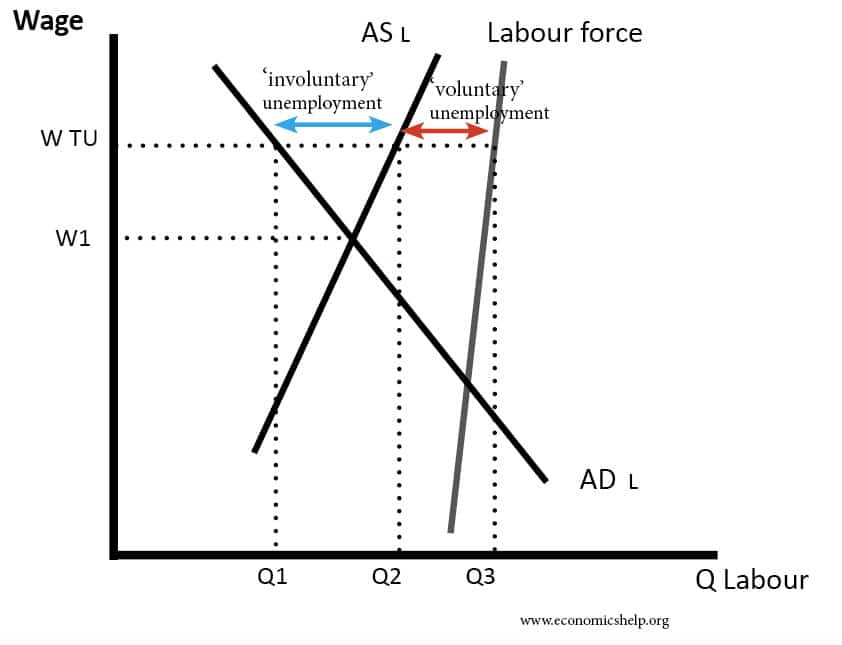Involuntary unemployment is a situation where workers are willing to work at the market wage or just below but are prevented by factors beyond their control. These factors could include deficiency of aggregate demand, labour market inflexibilities, implicit wage bargaining and efficiency wage theory.
- In Keynesian theory, involuntary unemployment is associated with insufficient aggregate demand and so is closely related to demand deficient unemployment.
- Other economists such as Stiglitz and Shapiro point to efficiency wage theories causing wages to rise above market equilibrium.
Reasons for involuntary unemployment
Implicit contract theory. Theoretically, unemployed workers may be willing to accept a job for a lower wage rate than market wage. However, in practice, there are difficulties in actually offering a lower wage. There is an implicit understanding that workers shouldn’t undermine workers in work. It would be socially embarrassing to take a job off your friend by undercutting their wage rate. Therefore, workers are unwilling to actually offer to take jobs for lower wages.
Trade unions. If trade unions successfully bargain for wages above the equilibrium, then those ‘outside’ the trade union are prevented from accepting a job at a lower wage rate.
Efficiency wage theory. This theory states that firms pay workers above the market clearing wage rate because it improves the productivity of workers. By paying a higher wage, workers are more attached to their job and work harder to avoid losing it. The efficiency wage theory states why wages are above the equilibrium in the first place.
Shapiro–Stiglitz efficiency wage model. This model argues that at full employment, a sacked worker finds it very easy to find new employment and this encourages ‘shirking’. Therefore, firms push up wages and reduce employment. This increases the cost of losing a job but causes involuntary unemployment
Involuntary unemployment and deficient demand. In the Keynesian model, one reason for involuntary unemployment is deficient aggregate demand. If aggregate demand falls, this leads to involuntary unemployment because wages are ‘sticky downwards.’ Cutting real wages will not solve this unemployment because cutting real wages will lead to further fall in aggregate demand. The solution is to increase aggregate demand.
Adaptive expectations – According to E. Phelps workers and firms may set wages based on adaptive expectations (e.g. high inflation in past causes them to demand rise in nominal wages). This can cause wages above market clearing levels.
Diagram showing involuntary unemployment due to wages kept above equilibrium

In this diagram, the ‘involuntary unemployment’ is the unemployment caused by wages artificially kept above market equilibrium (in this case trade unions). In theory, the unemployed would work for lower wages but are prevented.
Alternative definitions of involuntary unemployment
“Unemployment clearly does not include the idleness of wage earners, but only that part of it which is, from their point of view and in their existing conditions at the time, involuntary. … There is also excluded the idleness of those who are idle, not from necessity, but from choice. … The amount of unemployment, let us therefore say, which exists in any industry, is measured by the number of hours’ work by which the employment of the persons ‘attached to’ or ‘occupied in’ that industry fall short of the number of hours work that these persons would have been willing to provide at the current rate of wages under current conditions of employment”
Arthur Pigou (1914) Unemployment, pp. 14-17)
“Involuntary unemployment arises because of a malfunctioning of the economic system: it is not that individuals lack the willingness or ability to work but rather that the economy is failing to provide them with the opportunity to do so.”
Coddington A (1982) Keynesian Economics,
“Men are involuntarily unemployed if, in the event of a small rise in the price of wage-goods relatively to the money-wage, both the aggregate supply of labour willing to work for the current money-wage and the aggregate demand for it at that wage would be greater than the existing volume of employment. …It follows from this definition that the equality of the real wage to the marginal disutility of employment proposed by the second postulate, realistically interpreted, corresponds to the absence of ‘involuntary unemployment’.
(Keynes General Theory, section, IV Chapter 2 1936:15)
“Keynesian involuntary unemployment is defined, of course, as the situation in which unemployed workers are willing to accept employment at currently prevailing real wages (or slightly lower wages) or as the situation in which employment can be increased by increasing effective demand with an unchanged level of real wages.”
Negishi, T. (1979), Microeconomic Foundations of Keynesian Macroeconomics, North- Holland,
Criticisms of Involuntary unemployment
Robert Lucas argues there is no involuntary unemployment as the unemployed will always be able to find some kind of work. Lucas explains unemployment through real business cycle theories and changes in workers preference for work/leisure and productivity.
Links to other types of unemployment
- Voluntary unemployment – when workers choose not to accept a wage at going wage rate because they hope to find better job
- Real Wage Unemployment Real wage unemployment (classical unemployment). In classical model wages above equilibrium (e.g. caused by trade unions) will cause involuntary unemployment. Reducing power of trades unions will solve unemployment.
- The difference between classical model and Keynesian model is that Keynes argues cutting real wages may have impact on aggregate demand causing lower labour demand not solving the ‘involuntary unemployment;
- Demand deficient unemployment – according to Keynes deficiency of demand is primary reason for ‘involuntary unemployment’
Related
External links
- Involuntary unemployment in Keynes’ General Theory
